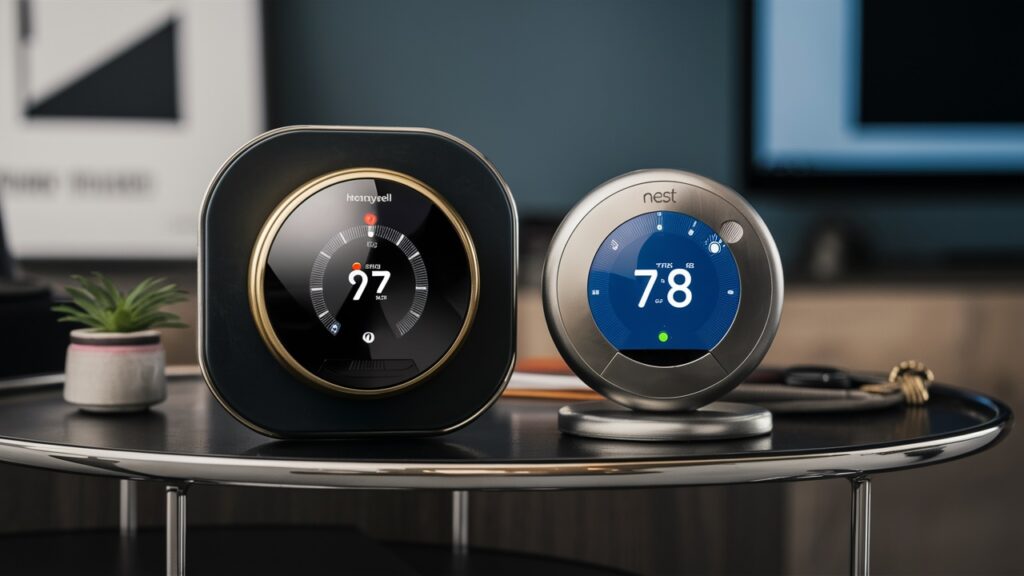Honeywell thermostats offer reliability and extensive compatibility. Nest thermostats provide advanced features and a user-friendly interface.
Choosing the right thermostat can significantly impact your home’s energy efficiency and comfort. Honeywell and Nest are two popular brands, each with unique advantages. Honeywell is known for its traditional designs and compatibility with various HVAC systems. It appeals to users who prefer straightforward functionality.
On the other hand, Nest stands out for its smart technology, learning capabilities, and sleek design. It adapts to your schedule and preferences over time, optimizing energy usage. Understanding the differences helps you select the thermostat that best suits your lifestyle and needs. This guide compares these two leading options to help you make an informed decision.
Introduction To Smart Thermostats
Smart thermostats are changing how we control home temperatures. They learn from our habits and adjust settings automatically. Two popular options are the Honeywell Thermostat and the Nest Thermostat. Each offers unique features that enhance comfort and efficiency.
The Rise Of Home Automation
Home automation is becoming more common. Smart devices connect seamlessly to simplify daily tasks.
- Control devices remotely through apps
- Schedule settings for convenience
- Integrate with other smart home devices
Smart thermostats play a key role in this trend. They provide users with control and flexibility. Homeowners can adjust settings from anywhere using their smartphones.
Energy Efficiency And User Convenience
Energy efficiency is crucial today. Smart thermostats help reduce energy waste. They optimize heating and cooling based on user habits.
| Feature | Honeywell Thermostat | Nest Thermostat |
|---|---|---|
| Learning Capability | Moderate | Advanced |
| Remote Access | Yes | Yes |
| Energy Reports | No | Yes |
Both thermostats offer convenience features. Users can set schedules easily. They also receive alerts for maintenance.
- Automatic temperature adjustments
- Smart alerts for system issues
- Energy usage insights
Choosing the right thermostat can enhance comfort. It can also save money on energy bills.
Honeywell Thermostat: Key Features
The Honeywell Thermostat offers many features. These features enhance comfort and energy efficiency. Let’s explore some key functionalities.
Customizable Interface
The Honeywell Thermostat includes a user-friendly interface. You can easily navigate the settings. Personalize your home’s temperature control with simple taps. Choose your preferred display options.
- Multiple screen themes
- Large, clear display
- Easy-to-read font sizes
This customization allows you to match your home decor. Enjoy a thermostat that fits your style.
Geofencing Technology
The Honeywell Thermostat uses geofencing technology. It tracks your location through your smartphone. This feature ensures your home is comfortable when you arrive.
- Set boundaries around your home.
- The thermostat adjusts temperature as you approach.
- Save energy when no one is home.
This technology offers convenience and energy savings. No need to adjust settings manually.
Energy Reports
Honeywell provides energy reports to track your usage. These reports help you understand your energy consumption.
| Feature | Description |
|---|---|
| Monthly Reports | Receive summaries of your energy usage. |
| Usage Trends | Identify patterns in your heating and cooling. |
| Tips for Savings | Get personalized suggestions to lower costs. |
These reports empower you to make informed decisions. Lower your bills while staying comfortable.
Nest Thermostat: Key Features
The Nest Thermostat stands out with its innovative features. It adapts to your lifestyle. This makes it easier to save energy and stay comfortable.
Learning Algorithm
The Nest Thermostat uses a smart learning algorithm. It learns your schedule over time. It remembers your temperature preferences. This means it adjusts automatically.
- Adapts to your routine.
- Creates a personalized heating schedule.
- Reduces energy bills.
Home/away Assist
The Home/Away Assist feature detects if you are home. It uses sensors to figure out your location. It adjusts the temperature based on your presence.
This helps save energy when you are not home. You enjoy comfort when you return.
Hvac Monitoring
The Nest Thermostat provides HVAC monitoring. It keeps an eye on your heating and cooling system. You receive alerts for any issues.
- Prevent costly repairs.
- Maintain system efficiency.
- Get reminders for maintenance.
| Feature | Description |
|---|---|
| Learning Algorithm | Adapts to your schedule and preferences. |
| Home/Away Assist | Detects your presence and adjusts temperature. |
| HVAC Monitoring | Alerts for system issues and maintenance. |
Design And Aesthetics
Design and aesthetics play a crucial role in choosing a thermostat. Both Honeywell and Nest offer unique styles. Their designs can enhance your home’s look. Let’s dive into the physical appeal of each model.
Honeywell’s Physical Appeal
Honeywell thermostats have a classic design. They often feature a rectangular shape. The buttons are easy to press. The display is bright and clear. This makes it simple to read.
- Material: Sturdy plastic with a glossy finish.
- Colors: Available in white, black, and silver.
- Size: Compact, fits well on walls.
Honeywell models blend well with traditional and modern decor. They maintain functionality without sacrificing style. Users appreciate the solid build quality.
Nest’s Minimalist Design
Nest thermostats are known for their minimalist design. They feature a sleek, round shape. The smooth display adds elegance. This design fits seamlessly into any room.
- Material: Premium metal and glass surface.
- Colors: Available in black, white, and copper.
- Size: Slim profile, easy to install.
Nest’s user interface is intuitive. Users can easily adjust settings. The overall look is modern and stylish. It enhances contemporary home designs.
Installation And Setup
Setting up a thermostat can be a simple task. The choice between Honeywell and Nest often depends on your comfort level. Both brands offer unique features that can enhance your home’s efficiency.
Diy Vs Professional Installation
Installing a thermostat can be done by yourself or by a professional. Here’s a quick comparison:
| Installation Type | Pros | Cons |
|---|---|---|
| DIY |
|
|
| Professional |
|
|
Compatibility With Home Systems
Before choosing a thermostat, check its compatibility with your home systems. Here are some key points:
- Honeywell: Compatible with most HVAC systems.
- Nest: Works well with dual fuel and heat pump systems.
Verify if your existing wiring matches the thermostat’s requirements.
Check these factors for both models:
- Voltage requirements
- Type of heating or cooling system
- Smart home integration
App Integration And Smart Home Ecosystem
Both the Honeywell Thermostat and Nest Thermostat offer strong app integration. They enhance your smart home experience with various features. Understanding their capabilities helps you choose the best option.
Remote Access Capabilities
The Honeywell and Nest thermostats allow remote access. This feature lets you control your home temperature from anywhere.
- Honeywell Thermostat: Offers a user-friendly app for smartphones and tablets. You can adjust settings remotely and monitor energy usage.
- Nest Thermostat: Provides an intuitive app with similar functionalities. You can manage your schedule and view energy reports.
Both systems support voice commands through smart assistants. This makes temperature adjustments even easier.
Compatibility With Other Smart Devices
Integration with other smart devices is crucial for a seamless experience.
| Feature | Honeywell Thermostat | Nest Thermostat |
|---|---|---|
| Smart Home Platforms | Compatible with Alexa, Google Assistant, and Apple HomeKit | Works with Google Assistant and Alexa |
| Smart Sensors | Integrates with Honeywell security devices | Works well with Nest cameras and doorbells |
Both thermostats offer excellent compatibility. Choose based on your existing devices for the best integration.
Cost Comparison
Understanding the cost differences between Honeywell and Nest thermostats is crucial. This section highlights the initial investment and potential long-term savings of each option. Both thermostats have unique features that impact their pricing.
Initial Investment
The initial cost is an important factor for many homeowners. Here’s a quick comparison of the prices:
| Thermostat | Price Range |
|---|---|
| Honeywell Thermostat | $80 – $250 |
| Nest Thermostat | $130 – $250 |
Honeywell thermostats generally offer a wider price range. Basic models are affordable. Premium models include advanced features.
Nest thermostats have a higher starting price. They include smart features that justify the cost.
Long-term Savings
Long-term savings matter. Both thermostats can save money on energy bills.
- Honeywell:
- Energy-saving features reduce costs.
- Programmable options allow for efficient schedules.
- Nest:
- Learning capabilities adjust to your habits.
- Remote access helps manage usage.
Here’s a comparison of estimated savings:
| Thermostat | Estimated Annual Savings |
|---|---|
| Honeywell | $50 – $100 |
| Nest | $70 – $130 |
Both thermostats help reduce energy costs over time. Choose based on upfront costs and long-term benefits.
User Reviews And Market Reputation
The popularity of the Honeywell Thermostat and the Nest Thermostat is undeniable. Both devices have their fans, and user experiences highlight key differences. Understanding consumer feedback and expert opinions helps potential buyers make informed choices.
Consumer Feedback
Users share their experiences with both thermostats. Here’s a summary of consumer reviews:
| Feature | Honeywell Thermostat | Nest Thermostat |
|---|---|---|
| Ease of Use | Simple interface. Users find it easy to navigate. | Intuitive design. Easy to program and control. |
| Energy Savings | Many report noticeable savings after use. | Highly praised for energy efficiency and savings. |
| Smart Features | Basic smart features available. | Advanced features, including geofencing. |
| Price | Generally more affordable. | Higher price point but justified by features. |
- Honeywell users appreciate the straightforward design.
- Nest users enjoy the smart learning capabilities.
- Both brands receive praise for customer support.
- Many users recommend both thermostats based on personal needs.
Expert Opinions
Experts evaluate both thermostats based on features and performance. Here are key insights:
- Honeywell Thermostat: Known for reliability and user-friendly design.
- Nest Thermostat: Recognized for its advanced technology and smart features.
- Experts highlight energy efficiency in both models.
- Installation is easy for both devices, with clear instructions.
Overall, both thermostats have solid reputations. Users appreciate their unique benefits. The choice often depends on individual preferences and needs.
Environmental Impact
The choice between Honeywell and Nest thermostats affects our planet. Both brands aim to reduce energy consumption. This section explores their environmental impact through energy saving certifications and sustainable design considerations.
Energy Saving Certifications
Energy saving certifications highlight a product’s efficiency. Here’s how Honeywell and Nest compare:
| Feature | Honeywell | Nest |
|---|---|---|
| Energy Star Certified | Yes | Yes |
| Smart Home Compatibility | Compatible | Highly Compatible |
| Energy Reports | Monthly | Weekly |
Both thermostats have the Energy Star certification. This means they meet strict energy efficiency guidelines. Honeywell provides monthly energy reports. Nest offers more frequent weekly reports. These insights help users save energy and reduce costs.
Sustainable Design Considerations
Sustainable design is crucial for reducing environmental footprints. Both brands focus on eco-friendly materials and practices.
- Honeywell: Uses recycled materials in manufacturing.
- Nest: Emphasizes a sleek, minimalistic design.
- Both:
- Designed for easy installation and long life.
- Support energy-saving features like scheduling.
Honeywell aims for recyclability. Nest focuses on aesthetics without sacrificing functionality. Both brands promote energy efficiency through smart technology.

Final Thoughts
Choosing between the Honeywell Thermostat and the Nest Thermostat involves understanding your needs. Each device offers unique features. Your decision can impact your energy savings and comfort.
Choosing The Right Thermostat For Your Home
Consider these key factors:
- Compatibility: Ensure the thermostat works with your HVAC system.
- User Interface: Check the ease of use and design.
- Smart Features: Look for features like remote access and learning capabilities.
- Energy Efficiency: Assess how each model can save energy.
- Price: Compare costs and find a budget that fits.
Here’s a quick comparison:
| Feature | Honeywell Thermostat | Nest Thermostat |
|---|---|---|
| Smart Learning | No | Yes |
| Remote Access | Yes | Yes |
| Energy Reports | No | Yes |
| Installation | Easy | Easy |
Future Trends In Smart Climate Control
The future of smart thermostats looks bright. Innovations will enhance energy efficiency and user experience.
- AI Integration: More devices will use artificial intelligence for better learning.
- Voice Control: Voice assistants will become standard features.
- Enhanced Connectivity: Thermostats will connect with other smart home devices.
- Data Analytics: Users will receive deeper insights into energy usage.
Investing in smart climate control technology brings comfort and savings. Choose wisely to enjoy a better home environment.
Frequently Asked Questions
Honeywell Thermostat Vs Nest: Which Is Better?
Honeywell Thermostats are known for reliability and user-friendliness. Nest Thermostats excel in smart features and energy efficiency. Your choice depends on whether you prioritize traditional functionality or advanced technology. Both offer distinct advantages, so consider your specific needs before deciding.
How Does Nest Learn Your Schedule?
Nest Thermostats utilize machine learning to adapt to your habits. They track your temperature preferences and when you’re home or away. Over time, Nest creates a personalized schedule that optimizes energy use. This feature helps save on energy bills while maintaining comfort.
Are Honeywell Thermostats Compatible With Smart Home Systems?
Yes, many Honeywell Thermostats are compatible with smart home systems. They can integrate with platforms like Amazon Alexa and Google Assistant. This allows for voice control and remote access via smartphone apps. Check specific models for compatibility details before purchasing.
What Is The Price Difference Between Honeywell And Nest?
Honeywell Thermostats typically range from $100 to $250. Nest Thermostats are usually priced between $130 to $250. The cost often reflects features like smart learning and remote access. Consider your budget and desired features when making a choice.
Conclusion
Choosing between a Honeywell thermostat and a Nest thermostat depends on your specific needs. Honeywell offers reliability and simplicity, while Nest provides advanced features and smart connectivity. Consider your priorities, such as ease of use or energy savings. Both options can enhance your home’s comfort and efficiency effectively.
Make an informed choice today!








